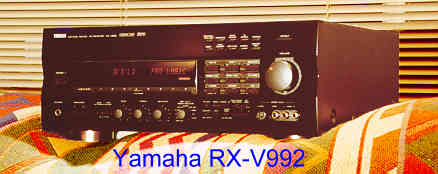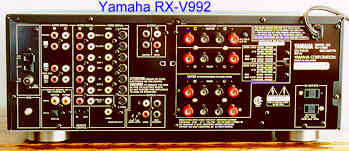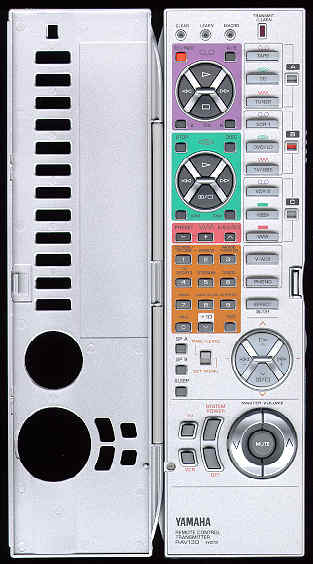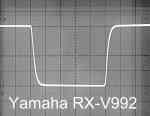Product Review - Yamaha RX-V992 Receiver
with Dolby Digital Processing - December, 1997
J.E. Johnson, Jr.
![]()
 |
Yamaha
RX-V992 DD Receiver 80 Watts/Channel in all Five Channels Pro Logic and Dolby Digital Decoding Digital Inputs for DVD DD Signals Size: 6 1/2" H x 17" W x 13 1/2" D Weight: 31 pounds Price: $999 USA
|
| Yamaha Electronics Corporation, USA,
6660 Orangethorpe Avenue, Buena Park, California 90620-1345 USA; Phone 800-292-2982 |
Based upon the success of the Yamaha RX-V990, which we have been using for some time in our reference home theater lab, we decided to follow up with the replacement model, the RX-V992. A number of things have been changed. One is that there is now equal amplification across all channels, i.e., 80 watts rms/channel. Secondly, Dolby Digital (DD) processing is now built-into the receiver. With the 990, we had to use an outboard processor, the DDP-1, for DD decoding. The DDP-2, which replaces the DDP-1, is a nice improvement on the DDP-1, not only in slightly less edginess of sound quality, but the front panel controls are much easier to access. The same DD processing electronics are in the DDP-2 as are in the RX-V992.
One thing that was omitted from the 992 that was on the 990 is a set of 5.1 input jacks. Even though DD is built-in, there are some consumers who might like to connect a DTS decoder, such as the Millennium 5.1. This can still be done, using the pre-out jacks, but this means putting a decoder between the pre-outs and an outboard five-channel power amplifier. I would prefer to have those 5.1 input jacks. Slider switches allow the user to select the impedance of the speakers, and whether two sets of speakers are connected to one set of speaker posts.

The back of the 992 is similar to many receivers, having myriad input and output jacks. Plenty of S-Video jacks are available for DVD and laserdisc users. There are several digital inputs for the audio from DVD and laserdisc. However, there is no AC-3 RF input, so if you want to use a laserdisc player with DD, you need an optional AC-3 RF demodulator ($99 from Yamaha). The speaker binding posts are all 3-way, like its predecessor. I am glad to see so many of the manufacturers getting rid of those spring clips.

The remote control for the 992 is a major change from previous remotes. It's a very complex remote, but then, today's choice of sources is also complex. Pretty much everything can be selected from the remote. Sixteen pages of the instruction manual are devoted to the operations of the remote, which shows you how much remotes can do these days. Inputs: Tape, CD, Tuner, VCR-1, DVD/LD, TV/DBS. VCR-2, Aux, Phono. Tape and Disc functions are controlled by two sets of buttons arranged in a circle.The master volume is also arranged in circular buttons, with a mute function in the center. Several DSP functions are included: Movie Theater, TV Sports, Stadium, Disco, Rock, Jazz Club, Church, and Hall. The DSP modes can be activated with Pro Logic and DD. I am not a fan of DSP modes, because they sound artificial, but they can spice up an otherwise unintersting CD or radio station now and then. The remote is of the learning variety, and can process macros. It is also illuminated (in red), and when a specific function is activated, other buttons associated with that function illuminate as well. Clever, and helpful.
The adjustment of individual channel volume is now an on-screen function, duplicated on the front panel display, using up and down buttons to select the channel and plus and minus buttons to change the volume. On the 990, you could adjust them with dedicated channel volume buttons. This is a trend that I have seen in numerous receivers of several manufacturers. Again, this is something I would have preferred to remain on the new models, but with all the new functions popping up, older dedicated button functions have to give. For this particular function, which is likely to be used quite often, you have to slide a switch on the remote to "Time/Level", then press the up arrow button on the circular set of buttons next to the slider switch. The arrow button selects the channel, which is displayed on the TV and on the front panel. After selecting the channel, the plus and minus buttons are used to change the volume either above or below 0 dB. If you are comfortable with on-screen commands, it is really not a problem. In keeping with the fact the 992 is a DD receiver, the left rear and right rear channel volume are individually adjustable, as opposed to the 990 where the rear channel volume was adjustable with both left and right rear together as one button.
The FM/AM tuner is of very high quality, with 40 station presets arranged under 5 sets of 8 each. Programming is simple. While other receiver functions come and go, FM/AM and the ubiquitous phono preamp circuit just get better and better. Too bad that there aren't enough really good FM stations out there to make use of all 40 presets. Vinyl may or may not be having its last gasp. The 992 instruction manual does not even mention the phono input, other than a picture of the turntable plugged into the appropriate jacks. Pro Logic and the sound fields work nicely with the FM/AM tuner. It's interesting to use Pro Logic to see which stations have good stereo separation. The ones with a lot of the signal going to mono, and just a little info to the stereo right/left, will have most of the sound going to center when Pro Logic is activated.
We feel the best video signal will be achieved by connecting the video source (e.g., LD and DVD) directly to the TV, rather than going through the receiver, regardless of the brand. Since function activation is displayed on the front panel of the receiver, as well as the TV (if going through the receiver), direct source-TV connections can be used without difficulty. There is also another option. If your TV has "PIP" (Picture in Picture), you can put the receiver function commands in the PIP window, and have the source being shown in the main window. First, you connect the video source to one input on the TV, direct. Then, the video output from the receiver is connected to a second input on the TV. By selecting the first input as the main window, and the second source as the PIP, you simply turn on the PIP each time you want to view the receiver function commands, and you can keep the main source direct to the TV rather than having to go through the receiver.
The front of the 992 is neatly laid out, with function activation being displayed on the orange LED panel. The tuner has lots and lots of presets. All inputs and DSP functions are individually selectable with their own buttons. The master volume control is a motorized potentiometer and has a neat little red LED to indicate its position in the dark. Treble, bass, and front left/right channel balance are rotary controls, as is the selector for which source you are interested in recording. Tone control bypass, bass extension (for deepening the bass), and speakers A and B (if you have a set of speakers in another room, for example) are push button-controlled, as is the power on/off control. A set of S-Video, composite video, and analog audio input jacks are conveniently located on the front for copying camcorder tapes onto the master family album.
You can tell I am a gadget-person. That's the main reason I like receivers. Lots of gadgets and options. But let's deal now with the main issue: How it performs. The changeover to 80 watts all around is a major improvement. The 990 had plenty of power up front, but almost nothing in the rear. Now that DD laserdiscs are plentiful, and DVD has DD as the standard sound format, you gotta have more power to the rear. The 992 has DD built-in, and Yamaha assumes you will use this capability if you buy the receiver, so . . . more power to the rear where it will be needed with those big DD sound effects coming from the rear.
The overall sound quality of the 992 was indistinguishable from the
990, except for clearer DD decoding and obvious addtional punch in the rear. With low
volume listening, there was no difference. We have to keep in mind however, that the
technology for receiver preamplification and power amplification has not changed much over
the past few years. It is the ICs for special functions that have changed. Even DSP modes
have not altered for some time. We can't suggest that the manufacturers eliminate these
ICs for sake of improving price point, because the ICs are not that expensive, and also,
selling mass market is a game of specsmanship.  The
10 kHz � 10 Volts square wave response looks much like many other amplifiers. But that
doesn't tell the whole story. Mass market receivers use a lot of negative feedback to
improve the harmonic distortion specification, and also to maintain the voltage at the
load when you crank the volume, because the power supply is not very big. This results in
a slightly mushy sound that is often too sibilant, and is a characteristic of all mass
market receivers. (It is not all that bad, just not as good as the dedicated processors,
but then, these receivers give you everything for $1,000. I would classify today's mass
market receivers as having "pretty darn good" sound, rather than the
"excellent - superb" sound of the $3,000 - $10,000 processors.) Also, the power
amplifier channel THD ratings are different, suggesting that the center and rear channel
amplifier sections are not quite as good as the front left/right. Yamaha is no different
from other manufacturers in this regard, as they have to compete just like everyone else.
For my own part, I wish they would use less feedback and lower the power amplifier
specifications. Let it put out less power, but cleaner power. The overall sound would be
improved . . . but they probably would not sell very many, because that ol' spec sheet is
what many, many consumers go by. The price would go way up too, and that would take it out
of the mass market arena. In any case, you can always use the pre-outs for connections to
an outboard power amplifier. Hey, I know. How about having just the
preamplifier/processing component section and a selection of power amplifiers to choose
from? In other words, the 992 would just have the preamplifier and decoder sections, with
a DB-25 output jack on the back, and a selection of five-channel amplifiers of, say, 80
watts rms/channel, 100 watts, 150 watts, and 200 watts, all with DB-25 input jacks. The
processor with all the functions would be great, because they probably would not have to
use so much negative feedback as the power supply would be dedicated just to the
preamplifier/processor functions. That is one drawback of using just the receiver
preamp/processor section with an outboard power amplifier. The negative feedback is still
there in the preamp (since it depends on a small power supply just as does the in-board
power amplifier). On the other hand, they could just beef up the power supply. So, why not
do this? Because the majority of mass market consumers want a one-box solution, and they
don't want to pay a lot for it. All the manufacturers are competing for that price
point. That's what mass market is all about. Satisfying the majority of consumers.
This market is worth billions, and. I don't blame manufacturers for catering to them.
Money talks. If the Mass Market Consumer can be persuaded that high quality sound is worth
the extra money, Yamaha and all the rest of the manufacturers will jump right in and make
high-performance receivers. They would be in the $1,500 - $4,000 range, and worth every
penny.
The
10 kHz � 10 Volts square wave response looks much like many other amplifiers. But that
doesn't tell the whole story. Mass market receivers use a lot of negative feedback to
improve the harmonic distortion specification, and also to maintain the voltage at the
load when you crank the volume, because the power supply is not very big. This results in
a slightly mushy sound that is often too sibilant, and is a characteristic of all mass
market receivers. (It is not all that bad, just not as good as the dedicated processors,
but then, these receivers give you everything for $1,000. I would classify today's mass
market receivers as having "pretty darn good" sound, rather than the
"excellent - superb" sound of the $3,000 - $10,000 processors.) Also, the power
amplifier channel THD ratings are different, suggesting that the center and rear channel
amplifier sections are not quite as good as the front left/right. Yamaha is no different
from other manufacturers in this regard, as they have to compete just like everyone else.
For my own part, I wish they would use less feedback and lower the power amplifier
specifications. Let it put out less power, but cleaner power. The overall sound would be
improved . . . but they probably would not sell very many, because that ol' spec sheet is
what many, many consumers go by. The price would go way up too, and that would take it out
of the mass market arena. In any case, you can always use the pre-outs for connections to
an outboard power amplifier. Hey, I know. How about having just the
preamplifier/processing component section and a selection of power amplifiers to choose
from? In other words, the 992 would just have the preamplifier and decoder sections, with
a DB-25 output jack on the back, and a selection of five-channel amplifiers of, say, 80
watts rms/channel, 100 watts, 150 watts, and 200 watts, all with DB-25 input jacks. The
processor with all the functions would be great, because they probably would not have to
use so much negative feedback as the power supply would be dedicated just to the
preamplifier/processor functions. That is one drawback of using just the receiver
preamp/processor section with an outboard power amplifier. The negative feedback is still
there in the preamp (since it depends on a small power supply just as does the in-board
power amplifier). On the other hand, they could just beef up the power supply. So, why not
do this? Because the majority of mass market consumers want a one-box solution, and they
don't want to pay a lot for it. All the manufacturers are competing for that price
point. That's what mass market is all about. Satisfying the majority of consumers.
This market is worth billions, and. I don't blame manufacturers for catering to them.
Money talks. If the Mass Market Consumer can be persuaded that high quality sound is worth
the extra money, Yamaha and all the rest of the manufacturers will jump right in and make
high-performance receivers. They would be in the $1,500 - $4,000 range, and worth every
penny.
In summary, the Yamaha RX-V992 is a natural upgrade from the excellent RX-V990. In my opinion, the 990 series is one of the best that Yamaha has ever built. The addition of DD decoding and equal power in all channels make this a good receiver to check out when revising your home theater, or starting a new one. It is incredibly flexible, sounds nice, and the price is right.
John E. Johnson, Jr.
![]()
� Copyright 1997 Secrets of Home Theater & High Fidelity
Return to Table of Contents for this Issue.

